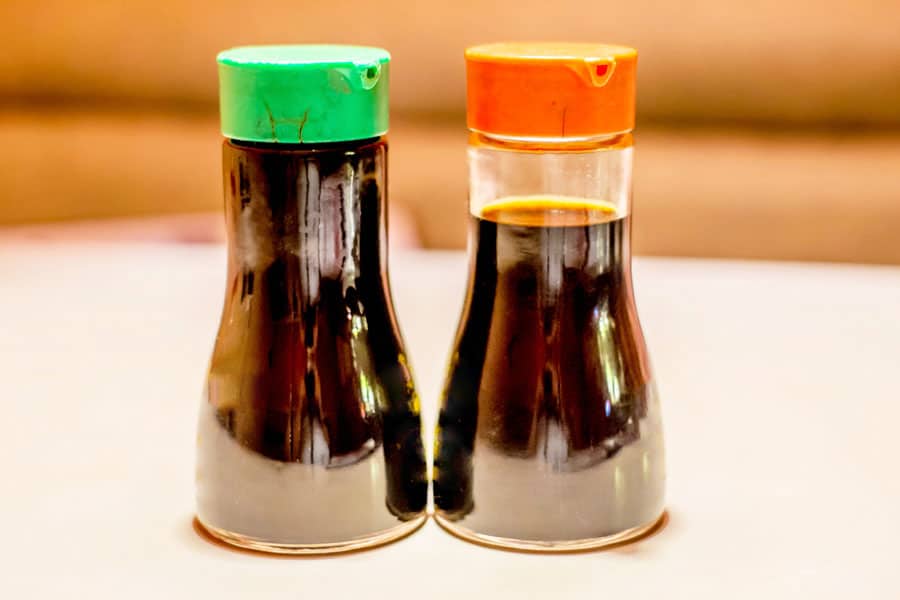Is Soy Sauce Gluten-Free?

Is soy sauce gluten-free | FDA regulations | Types | Alternatives | Brands | How to buy
Is soy sauce gluten free?
No, soy sauce is not gluten-free. Although soy itself is naturally gluten-free, soy sauce is not.
Traditional soy sauce is made from a fermented paste of soybeans, wheat, salt, and water. This means that soy sauce does contain gluten, and it is not safe for people on a gluten-free diet.
However, there are some soy sauce brands that make gluten-free soy sauce. These soy sauces are made with either rice or tamari.
What does the FDA say about soy sauce?
The Food and Drug Administration (FDA) [1]Federal Register: Food Labeling; Gluten-Free Labeling of Foods mandates that any product that is labeled “gluten-free” must contain less than 20 ppm of gluten.
For a product to be labeled “gluten-free,” it must be manufactured without any gluten-containing ingredients. In addition, it must not have come into contact with any gluten-containing surfaces during processing.
According to the Gluten-free watchdog group [2]Gluten Free Watch Dog: Updated statement from FDA on soy sauce, the FDA doesn’t allow soy sauce to be labeled gluten-free, even if it is fermented, unless it meets certain specific standards. This is because FDA believes that:
- Hydrolysis is not an effective way to remove gluten from food.
- Fermentation does not remove gluten from a product completely.
Types of gluten-free soy sauce
Since wheat-based soy sauce is not safe for people with celiac disease or gluten sensitivities, some gluten-free soy sauce options are available.
Although these typically mimic soy sauces, they differ from traditional soy sauces due to their ingredients.
Rice-based soy sauce
Rice soy sauce is made with rice instead of wheat. It is brewed and fermented in the same way as wheat-based soy sauce but does not contain gluten.
It is lighter in color and flavor than regular soy sauce. And it is a good all-purpose soy sauce that can be used in many dishes.
Tamari soy sauce
Tamari soy sauce is made with little to no wheat. In fact, most tamari soy sauces are made with 100% soybeans. This makes tamari a great option for those on a gluten-free diet.
Tamari also has a richer flavor than regular soy sauce, making it perfect for marinades and stir-fries.
Gluten-free alternatives to soy sauce
While soy sauce is not technically gluten-free, there are some alternatives that are safe for people on a gluten-free diet.
1. Coconut aminos
Made from coconut sap and sea salt, this alternative has a similar taste and consistency to soy sauce. It is also rich in amino acids, making it a healthy choice for those on a gluten-free diet.
2. Fish sauce
Fish sauce is made by fermenting fish in saltwater. It has a strong umami flavor that makes it perfect for adding depth to dishes like soups, stews, and curries. It is generally gluten-free and a great alternative for those looking to avoid soy sauce.
3. Dried mushroom sauce
Dried mushroom sauce is another umami-rich alternative to soy sauce. It’s made by rehydrating dried mushrooms by steeping them in water. While it’s not as salty as soy sauce, it does have a similar depth of flavor.
4. Worcestershire sauce
Worcestershire sauce is a fermented condiment made with vinegar, anchovies, tamarind, and a variety of other spices. It’s a great alternative to soy sauce for those on a gluten-free diet.
5. Liquid aminos sauce
Liquid aminos is a sauce made by sourcing protein concentrate from soybean that has not been fermented. It has a similar taste and consistency to soy sauce, making it a great alternative for gluten-free people.
List of gluten-free soy sauce brands
With emerging gluten-free food brands, people with celiac disease or gluten intolerance need not give up on their favorite taste and flavor categories. Here are some brands that offer gluten-free soy sauce options.
1. Kikkoman soy sauce
Kikkoman is a well-known brand of soy sauce, and its gluten-free version does not disappoint.
This soy sauce is made with water, salt, sugar, vinegar, and soybeans, so you can be sure that there are no hidden ingredients that could trigger your celiac disease or gluten intolerance. It has a rich, savory flavor that is perfect for stir fry or marinades.
2. San-J gluten-free soy sauce
San-J makes several different types of tamari soy sauces, teriyaki sauce, and stir fry sauces.
Their tamari is made with water, organic soybeans, salt, and organic sugarcane alcohol. It has a clean flavor that is perfect for those who are sensitive to additives.
3. Eden organic soy sauce
Eden’s organic gluten-free soy sauce is made with water, organic soybeans, salt, organic alcohol, and koji (steamed rice with cultivated koji mold spores).
This brand is certified organic by the USDA, so you can be sure that it meets strict quality standards. It has a slightly sweeter flavor than other brands of gluten-free soy sauce, thanks to the addition of cane sugar.
4. Wan Ja Shan soy sauce
Wan Ja Shan’s gluten-free soy sauce is made with water, salt, sugar, vinegar, and soybeans. It has a savory flavor that is perfect for marinades or as a dipping sauce.
This brand is also available in tamari style (made with no wheat) and wheat-free tamari style (made with no wheat or soy), so you can choose the version that best suits your needs.
5. La Choy soy sauce
La Choy gluten-free soy sauce is made with water, salt, hydrolyzed soy protein, corn syrup, caramel color, and potassium sorbate.
It is a slightly milder taste than traditional soy sauce and is a great alternative for those on a gluten-free diet.
Pick the right gluten-free soy sauce
Consuming soy sauce on a gluten-free diet is possible as long as you choose one that is certified gluten-free or made from ingredients that do not contain gluten.
So here are some tips for picking the right soy sauce when you are on a gluten-free diet.
1. Read labels carefully
When you’re at the grocery store, be sure to read the labels carefully to make sure that the soy sauce you’re buying is 100% gluten-free. Look for the “gluten-free” label on products to be extra sure.
2. Check the ingredients
Most commercially-available soy sauce contains gluten from wheat. In addition to wheat, some soy sauces also contain barley or rye. These grains also contain gluten and should be avoided.
So when you’re checking ingredients, put that soy sauce back on the shelf if you find any mention of these ingredients.
However, some brands make gluten-free soy sauce with plain soybean or other gluten-free ingredients. The ingredients list will help you with this information.
3. Keep sodium in mind
The American Heart Association [3]American Heart Association: How much sodium should I eat per day? recommends 1500 mg to 2300 mg of sodium per day. According to USDA, soy sauce contains about 879 milligrams of sodium per tablespoon.
This means that just one tablespoon of soy sauce can quickly add up to your daily recommended sodium intake. Thus, when choosing a gluten-free soy sauce, keep an eye on the sodium content and opt for low-sodium gluten-free soy sauce.
4. Look for possible cross-contamination
Even if a particular brand of soy sauce is labeled “gluten free,” that doesn’t mean that it’s totally safe for those with celiac disease or gluten intolerance. That’s because of the risk of cross-contamination during production.
If a factory produces both gluten-containing and gluten-free products along the same lines, there’s a chance that wheat traces end up in the final product—even if it’s just a few stray particles.
If you’re particularly sensitive to gluten or have celiac disease, it’s best to buy gluten-free soy sauces produced in a dedicated gluten-free facility. This will help ensure that there’s no risk of cross-contamination during production.
5. Consider taste
One final thing to keep in mind when choosing soy sauce is taste. Just because a particular brand is labeled “gluten free” doesn’t mean that it will taste as good as your favorite regular soy sauce.
Some brands add different herbs or spices to their recipes to compensate for the lack of wheat flavor, while others rely on hydrolyzed vegetable protein—a common flavor enhancer—to give their product more umami flavor.
So if you’re looking for a soy sauce that tastes just like your old favorite, you might need to do some trial and error before you find one that hits all the right notes.
Conclusion
With these varieties of gluten-free soy sauce options, you don’t need to miss out on the umami flavor of soy sauce. However, celiac disease is a serious autoimmune disease that is triggered by gluten.
So, if you have celiac disease, it’s important to consult with your doctor before trying any of these soy sauce alternatives.
References
| ↑1 | Federal Register: Food Labeling; Gluten-Free Labeling of Foods |
|---|---|
| ↑2 | Gluten Free Watch Dog: Updated statement from FDA on soy sauce |
| ↑3 | American Heart Association: How much sodium should I eat per day? |







